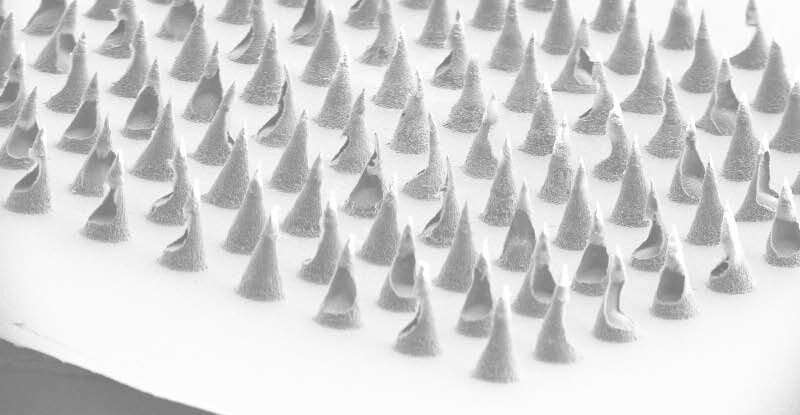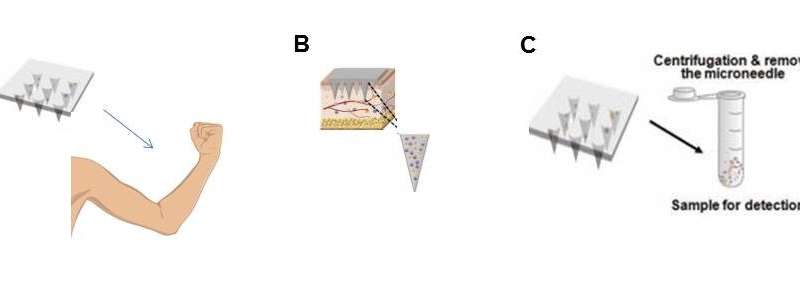Extraction of skin interstitial fluid using microneedle patches
by Science X staff
Interstitial fluid is a major component of the liquid environment in the body and fills the spaces between the body's cells. In contrast, blood circulates only within the circulatory vessels of the body and is composed of blood cells and the liquid part of the blood, plasma. Both fluids contain special components called biomarkers, which are valuable indicators of bodily health. These biomarkers include various types of molecules such as proteins, hormones or DNA, and can also include drugs and metabolites.
When monitoring patient health, the standard source for the measurement of biomarkers is blood. Samples are drawn by venous puncture, most often from the forearm or from the veins in the hand. Occasionally there are problems in drawing blood when the veins are subject to collapse, or when they are very small or difficult to locate. Still other problems may occur when the veins "roll" or move from side to side. And as in any procedure that involves a wound to the skin, there is always the risk of infection that is introduced. The problems are compounded when patients are required to submit multiple samples over time.
In order to circumvent these problems, and to make improvements in patient health monitoring, scientists have turned to alternative sources for obtaining samples for biomarker testing. The interstitial fluid is an ideal choice for this purpose. It offers an advantage over blood in being a reservoir for certain site-specific drugs and drugs in a more active state. And it is a rich source of biomarkers, metabolites and therapeutic drugs, found in abundance just below the outermost layer of the skin. For these reasons, researchers have devised ways to access this source.
One method that has recently been focused on is the use of microneedle patches. Such patches are fabricated from liquid-absorbing materials that are molded into a patch, with an array of tiny microneedles that are approximately 600 micrometers in length, about the length of a grain of salt. The patch is then applied directly on the skin for a specified period of time, interstitial fluid is drawn into the patch, and the patch is then removed and processed to collect the fluid.

A research team led by Ali Khademhosseini, Ph.D., the Director and CEO of the Terasaki Institute, who was previously Director of the University of California, Los Angeles (UCLA) Center for Minimally Invasive Therapeutics, have devised such a patch and optimized conditions for its performance. This microneedle patch utilizes a gel made of a substance called gelatin methacryloyl (GelMA), a hydrogel with highly-absorptive capabilities and demonstrable strength. This substance was chosen for these qualities over other materials in previous use, as well as for its biocompatibility and the ability to adapt its composition to optimize performance.
The gel was molded into a patch with an array of solid-gel microneedles on one face. The Terasaki team has performed extensive testing to determine the optimum gel concentration, degree of gel cross-linking and cross-linking time needed to produce a patch that provides the best absorptive properties, needle strength and skin penetration. The effectiveness of the patch gel's fluidic capabilities also eliminates the need for fabrication of hollow needles, which simplifies production.
The team did comparison studies of drug and glucose levels measured from samples extracted with the GelMA patch versus blood collected by conventional means and the results were highly comparable. There was also an improvement in the volume of fluid collected with the GelMA patch over other microneedle patches.
"Collecting samples from patients in a non-invasive manner is important, particularly in the COVID era," says Dr. Khademhosseini. "We are excited about the microneedles developed here, as they open up rapid ways to collect patient samples in a simple and painless manner."
The GelMA patch developed by the Terasaki Institute delivers an improvement in design, cost effectiveness ease of production, and convenience; its unique qualities were recently featured as the cover story in a recent issue of Small.
More information: Jixiang Zhu et al, Gelatin Methacryloyl Microneedle Patches for Minimally Invasive Extraction of Skin Interstitial Fluid, Small (2020). DOI: 10.1002/smll.201905910
Journal information: Small
Provided by Terasaki Institute for Biomedical Innovation